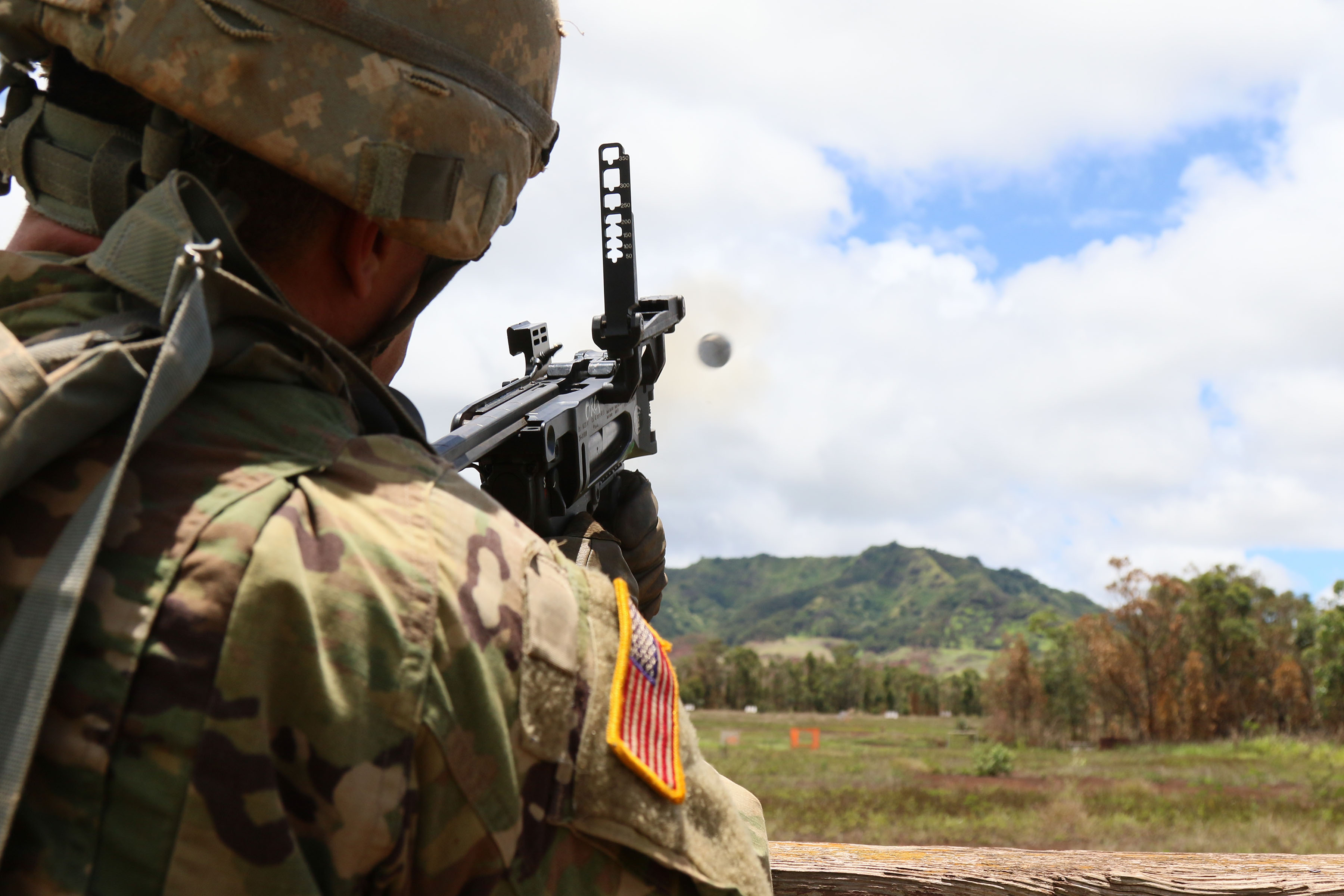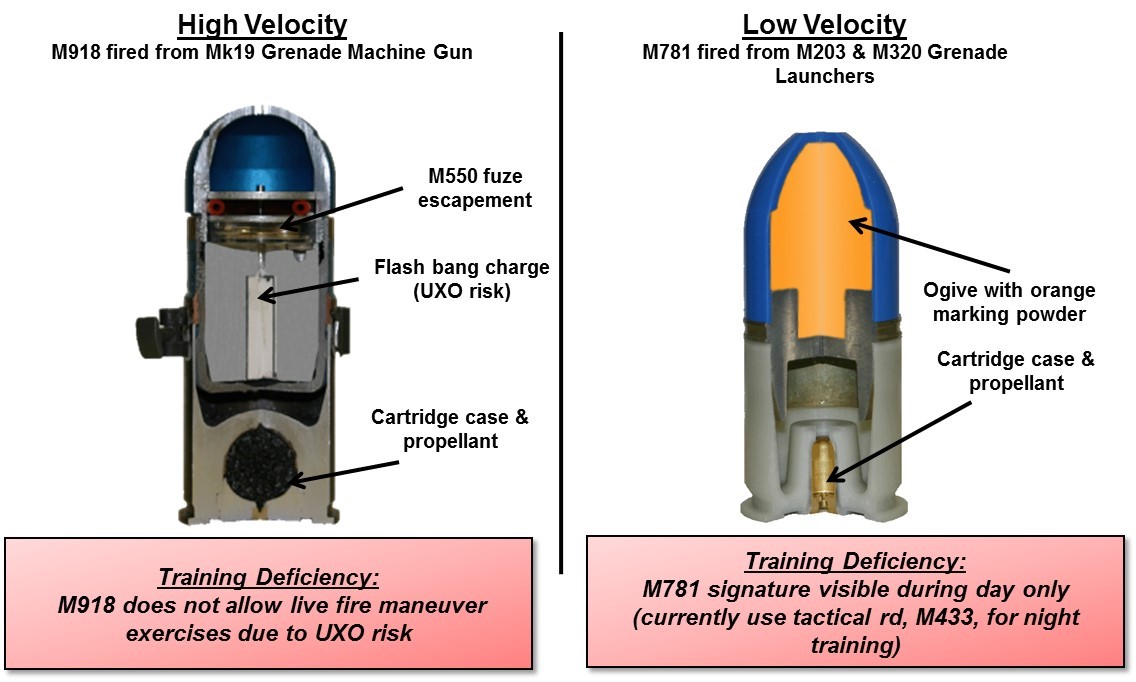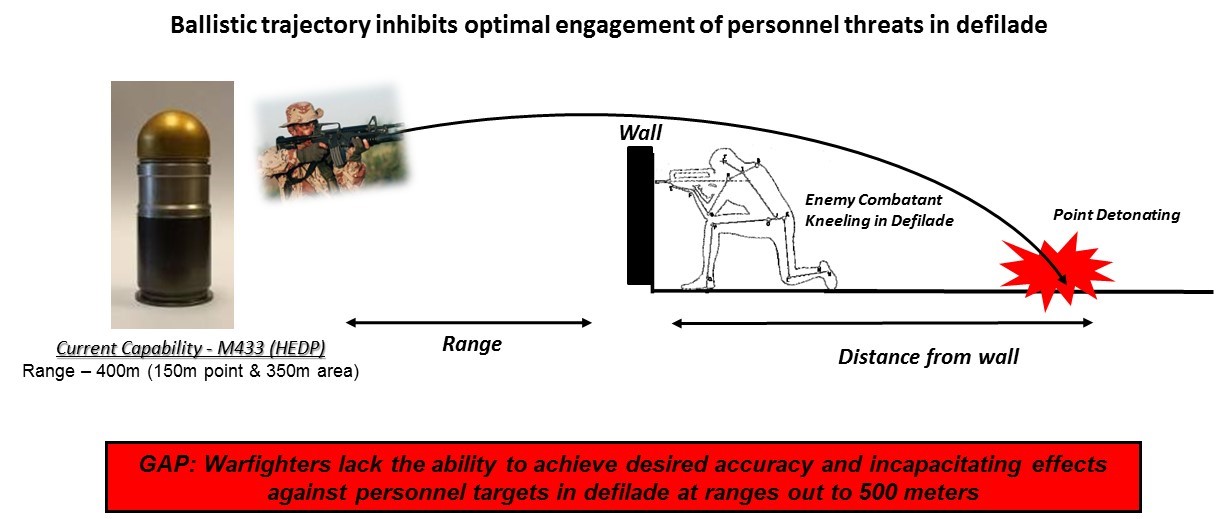
New family of munitions enhances training and increases capabilities and lethality.
by Mr. James Terhune
For nearly 30 years, 40 mm grenades have been a mainstay on the battlefield, undergoing little more than safety and reliability improvements. In 2009, the Army set out to take advantage of new technologies to help counter evolving threats and new tactics and to provide more realistic training to warfighters. The Product Director for Medium Caliber Ammunition (PD MCA), part of Project Manager Maneuver Ammunition Systems (PM MAS), has created plans for the development of the next generation of 40 mm grenades.
The 40 mm grenade family contains both high-velocity (HV) grenades, which are fired from Mk19 grenade machine guns (GMGs) mounted on vehicles as well as dismounted, and low-velocity (LV) grenades, which are fired from handheld weapons. The primary 40 mm HV tactical round is the M430A1 High-Explosive Dual Purpose (HEDP) cartridge. It is fired to a maximum range of 2,200 meters and is capable of penetrating three inches of steel and inflicting personnel casualties. The primary 40 mm HV training round is the M918/M385A1 Mixed Belt Target Practice (TP) configuration. It provides a realistic signature, defined as a distinguishable visual characteristic or mark, that can be seen as far out as 1,200 meters.
LV grenades are used with the handheld M203 and M320 grenade launchers. The primary 40 mm LV tactical round is the M433 HEDP, which is designed to penetrate lightly armored targets and inflict personnel casualties in the target area. The primary 40 mm LV training round is the M781 TP cartridge, which provides a signature for daytime training only.

U.S. Soldiers assigned to 1-10th Special Forces Group fire an Mk19 grenade launcher at Baumholder Military Training Area, Germany, in May. Ammunition currently being developed for the Mk19, the I-HEDP, will increase the accuracy and lethality of Mk19 gunners and allow them to engage and defeat targets with less ammunition than the existing M430A1 HEDP. (U.S. Army Photo by Erich Backes)
NEW CAPABILITIES
From 2008 to the present, PD MCA has worked with the U.S. Army Maneuver Center of Excellence (MCoE) to generate and coordinate multiple 40 mm Family of Ammunition (FoA) capability development documents (CDDs) and capability production documents (CPDs) to bring new capabilities to the warfighter. These documents identified a number of capability gaps:
- “Provide the Soldier the ability to fully train on the capabilities of the 40 mm GMG and develop the skills necessary to conduct military operations. Non-dud producing: Greater maneuverability for Soldiers and platforms. Engage targets under limited visibility – Takes full advantage of night vision devices.” – Several initial capability documents (ICDs), joint capability documents and related CDDs and CPDs.
- “Warfighters lack the ability to achieve desired accuracy and incapacitating effects against personnel targets in defilade [protected from hostile ground observation and flat projecting fire by an obstacle, such as a wall or hill], at ranges out to 500 meters.” – Small Arms Capabilities-Based Assessment (CBA), April 2008.
- “… Precisely and quickly defeat, out to 500 meters, enemy combatants, their personal equipment, and thin-skinned targets in defilade positions while limiting collateral damage.” – Counter Defilade Target Engagement CDD, January 2011
- “Squads lack the ability to conduct ballistic breach at ranges up to 50 meters and conduct rapid (single-shot) breach without pause between actual breach and entry of initial force.” – Small Arms CBA, April 2008.
- “Platoons lack the ability to achieve desired accuracy and incapacitating effects with volume fire up to 2,400 meters.” – Small Arms CBA, April 2008.
- “The solution set with the highest potential was the development of an integrated airburst weapon system … consisting of an integrated weapon, target acquisition/fire control and ammunition. An integrated airburst weapon system provides a significant capability for engaging targets in defilade, one of the more challenging tasks identified in the [Small Arms] CBA.” – Counter Defilade Target Engagement ICD, August 2008
The 40 mm FoA CDDs and CPDs have established the Army’s requirements for the HV and LV 40 mm grenade families to be revamped to increase training readiness and lethality, and have enabled the start of multiple research and development programs. Several programs are currently in a range of development stages:
- 40 mm HV/LV TP – Day Night Thermal (TP-DNT) M918E1/M781E1: Provides an impact signature that can be seen day or night, by the unaided eye and through current and future thermal and night vision sights. It achieved milestone C in May 2017.
- 40 mm High Explosive Air Burst (HEAB), LV, XM1166: Provides enhanced accuracy, lethality and range against infantry in the open and in defilade. It will achieve milestone B in FY18.
- 40 mm Door Breach, LV, XM1167: Allows for an in-stride ballistic breach—eliminating the need to set up additional, cumbersome equipment—of a door at ranges up to 50 meters, creating an entry point into a building or other urban structure. It will achieve milestone B in FY18.
- 40 mm HV, Improved High Explosive Dual Purpose (I-HEDP): Provides enhanced accuracy and lethality to defeat a target in the open and defilade. It will achieve milestone B in FY18.

In addition to developing ammunition that’s fielded to troops in theater, PM MAS and PD MCA developed solutions to improve ammunition used in training while complying with requirements for unexploded ordnance. Over a five-year production timeframe, the HV TP-DNT training round would save approximately $98 million over costs associated with the current M918 round, left, and the LV TP-DNT would save about $3 million when compared with costs for the M781 round. (Image courtesy of PM MAS)
ENHANCED TRAINING
Training on the systems that Soldiers use in combat, including the 40 mm grenade family, improves readiness and mission effectiveness. The Army and other services use 40 mm grenade machine guns and grenade launchers within the tactical environment for offense, defense, patrolling and urban operations in all environments day and night. Improvements in night-fighting capabilities, including thermal sights, and battlefield tactics have led to training gaps for LV grenade training. Additionally, unexploded ordnance (UXO) concerns restrict HV grenade training to static firing ranges, which allow only dud-producing munitions and limited maneuver training. Dud-producing munitions are rounds that contain explosives in which their fuze has not initiated. Although the M918 Training Round contains very little explosive and the probability of a dud is less than 1 percent, they still can pose an unexploded ordnance risk.
By FY19, the 40 mm TP-DNT program will make training more realistic by delivering 40 mm HV and LV grenade training cartridges with impact signatures that can be seen at any time, by the unaided eye and through current and future thermal and night vision sights. The cartridges will contain pyrophoric material, which produces the visible signature, and replaces the existing explosive, thereby removing the UXO risk and allowing Soldiers to conduct maneuver training exercises. In addition, the program will provide the Army a significant cost savings over the munitions life cycle while increasing warfighter readiness. A cost-benefit analysis, submitted with the requirements packet, showed that over a five-year production timeframe, HV TP-DNT saves approximately $98 million over current M918 costs, and LV TP-DNT saves about $3 million over current M781 costs.
Airburst technology is being developed for the M203/M320 weapon platform to provide rapid defeat of defilade personnel targets at extended ranges, effectively increasing warfighter readiness by providing state-of-the-art technology with new engagement capabilities. When deployed against point and area targets, such as a single enemy combatant in defilade or multiple enemy combatants in the open, the HEAB XM1166 cartridge will enable a grenadier to inflict incapacitating effects against personnel at increased ranges beyond those offered by the current M433 HEDP—up to 600 meters, from the current range of 400. Additionally, the increased range of the XM1166 will allow grenadiers to employ lethal effects against targets throughout the full range of military operations with improved accuracy and at greater standoff ranges, increasing survivability.
Today, Soldiers conduct structure breaching with mechanical, explosive and ballistic methodologies. Mechanical and explosive methods put Soldiers at an increased risk of injury because of the close proximity to the enemy. The Grenade Rifle Entry Munition, the current ballistic method, is heavy, requires a long engagement time, is difficult to accurately place on the target and yields extensive collateral damage. The 40 mm Door Breach LV XM1167 provides small units with a lightweight round that can conduct a ballistic breach at ranges up to 50 meters without pause between actual breach and entry of the initial force. This allows units to quickly gain access to a building at a safe distance, while enabling them to gain and maintain a tactical advantage. The cartridge will be lightweight, reducing the Soldier’s load, and has a low recoil force when fired from the M4/M320, minimizing fatigue. The XM1167 cartridge is expected to be fielded in FY20, and will greatly enhance the warfighter’s effectiveness in military operations in urban terrain while increasing safety and survivability.
A 40 mm HV airburst munition CDD is currently going through the Joint Capabilities Integration Development System process, with approval expected by Sept. 30, 2017. The I-HEDP is a high-explosive munition that will be able to engage personnel targets in defilade and in the open and defeat unarmored and lightly armored vehicles. The combination of Mk19 and I-HEDP will incorporate a fire control and programming unit to allow the gunner to set one of two modes: airburst for concealed and exposed targets, and point detonation for material targets. Additionally, a self-destruct feature will be incorporated to reduce the chance of UXO on the battlefield. The I-HEDP will increase the accuracy and lethality of Mk19 gunners, allowing them to engage and defeat targets with less ammunition than the existing M430A1 HEDP. The I-HEDP is expected to be fielded by FY23.

With current ammunition options, warfighters lack the ability to engage personnel targets in defilade—concealed by obstacles like hills or walls. PM MAS is working on a handful of options that will eliminate that gap. (Image courtesy of PM MAS)
CONCLUSION
For the past eight years, the Army has invested in and developed an executable plan to modernize the 40 mm grenade family. Working together, PD MCA and the MCoE have crafted the requirements and culled the best technologies that will enable new advancements in technology to be incorporated into the 40 mm grenade family. Over the next several years, we will deliver new training capabilities to enhance Soldier readiness and develop and deliver new tactical capabilities to increase lethality in combat and win back the advantage.
For more information, please contact Mr. James Terhune at james.c.terhune2.civ@mail.mil.
JAMES TERHUNE is the lead for 40 mm research, development, testing and engineering within PM MAS. He holds an M.S. in technology management from Stevens Institute of Technology and a B.S. in industrial engineering from Lehigh University. He is Level III certified in program management, engineering, and business – financial management. He is a member of the Army Acquisition Corps.
This article will be published in the October – December 2017 Army AL&T magazine.
Subscribe to Army AL&T News, the premier online news source for the Acquisition, Logistics, and Technology (AL&T) Workforce.







